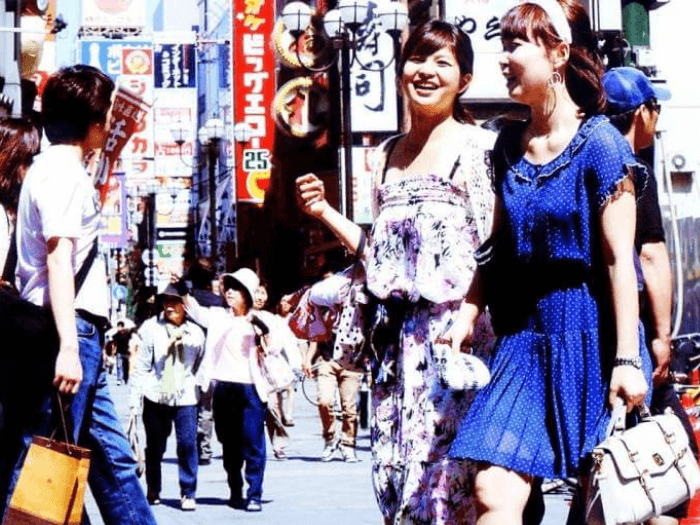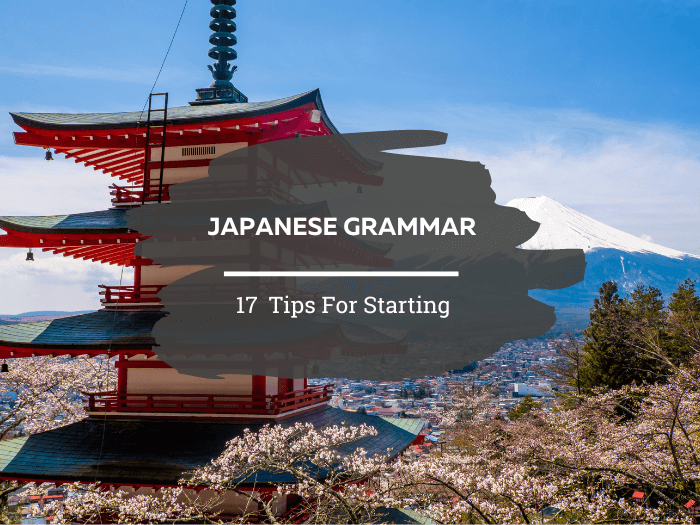When you’re just considering learning Japanese, it can be overwhelming to try to remember all the things you have to keep in mind.
You’ve no doubt heard people say that the Japanese language is tricky. And so, you might think that it’s going to be tough to master Japanese words and more complex sentences.
While it’s true that improving your language skills takes work, a couple of Japanese grammar basics form the basis of the entire language.
And if you can understand basic Japanese sentence structure, you’ll be well on your way to mastering this skill. You’ll pick up most aspects of Japanese best by immersing yourself in the language and developing a natural understanding of them.
That’s why you’ll likely take notice of a couple of basics of Japanese grammar right from the get-go.
Here are 17 key Japanese grammar rules that are simple to remember and will make it easier for you to get a grip on the language fast so you can get out there and start learning.
By the way, if you want to learn Japanese fast and have fun while doing it, my top recommendation is Japanese Uncovered which teaches you through StoryLearning®.
With Japanese Uncovered you’ll use my unique StoryLearning® method to learn Japanese naturally through story… not rules. It’s as fun as it is effective.
If you’re ready to get started, click here for a 7-day FREE trial.
Table of Contents
Tip #1: Japanese Has No Plural

It can be tough to wrap your mind around how people can go through life without singular and plural. But just give it a try. It turns out that knowing whether you have one or more than one isn’t as critical as you might think.
In Japanese, there is no (regular) use of the plural.
In other words, whether you want to say “I saw a cute dog today” or “I saw a couple cute dogs today,” the sentence would be exactly the same:
- Kyou, kawaii inu wo mimashita
- 今日、かわいい犬を見ました。
If you’re really broken up about it and absolutely need to clarify that there were “multiple” of something, you can append –tachi to the end of a noun.
But this is certainly not something that you’ll need to do every time you talk about something plural.
For example, kodomo 子供 (child) can become kodomotachi 子供たち(children).
Tip #2: Japanese Sentence Structure: Verbs Come At The End

One of the most famous features of the Japanese language is the inverted Japanese sentence structure, putting the verb at the end. This might seem confusing. But you’ll surprise yourself with how quickly this order becomes natural.
Take, for example, “I went to the library.” In the English sentence structure, this is represented by subject, verb, object: I > went > library.
In Japanese, this same sentence would appear as subject > object > verb:
- watashi ha toshokan ni ikimashita
- 私は図書館に行きました
- Lit: I library went
- 私は図書館に行きました
Over time, you might find that Japanese sentences and talking this way actually proves useful.
It helps you avoid confusion by keeping all your related sentence pieces together instead of sticking a verb right in the middle of everything you were trying to say.
Tip #3: You Don’t Say “You” In Japanese

You may be picking up on the idea that Japanese sentences tend to use fewer words than their English translations. And “you” is no exception.
If you’re talking to someone, it’s generally considered improper to directly address them as “you” (anata, あなた).
Typically, the better way to approach this issue is to use their name (or title), or just omit the whole idea of “you” to begin with.
That looks like this:
- “Do you like cake?”
- Anata ha ke-ki ga suki desu ka? あなたはケーキが好きですか。 X
- [Name]-san, ke-ki ga suki desu ka? 「名前」さん、ケーキが好きですか。✓
- Ke-ki ga suki desu ka? ケーキが好きですか。✓
The more polite Japanese is to opt for either of the second two options, as using anata can come across as a bit too direct.
If you don’t know someone’s name, that’s okay. As you can see from the third example, you don’t even need it!
Tip #4: Japanese Particles Help You Show The Function Of A Word

Grammatical particles—that’s the ha, ga, wo, no, mo, de, ni, to, and so on that you see coming in between words in Japanese—might seem like they don’t do much since they themselves don’t have meaning.
But instead, particles are a very important part of Japanese. Think of them like flags that mark what the pieces of a sentence are doing.
Take, for example, the particle no の, and let’s compare that to the particle ha は (pronounced “wa”) just to see how important these little guys are.
Consider this sentence:
- Tamaki no tegami wo kakimashita
- たまきの手紙を書きました。
- I wrote Tamaki’s letter.
- たまきの手紙を書きました。
That’s nice of you to do that for him so he doesn’t have to! Maybe he had an assignment he had to do, but you helped him do it instead. But look what happens when we change the particle no to ha:
- Tamaki ha tegami wo kakimashita
- たまきは手紙を書きました。
- Tamaki wrote a letter.
- たまきは手紙を書きました。
That’s a big difference, all thanks to a particle that has no meaning by itself!
You’ll learn some identifying features about each particle (for example, that no makes things possessive). Using the correct particle can change the meaning of your sentence and how the words in a sentence relate to one another. Just give these small guys the credit they deserve.
If you want to get your Japanese sentence structure right, you'll need to learn a few common Japanese particles. Check out this post for a full list of Japanese particles.
Tip #5: It’s Easy To Be Polite In Japanese
It’s a common idea that Japanese has very complex politeness levels built into the language. While you can’t deny that there are certainly a variety of politeness options to choose from, you don’t have to worry as much as you might think about offending people.
There’s no need to learn hyper-formal form keigo in order to speak to your teachers. By addressing most people with the typical verb endings of desu/masu, you’re using the polite form already.
While there is certainly a time and place for the very formal keigo and kenjougo, these situations are more likely to crop up when you’re speaking with a company president, political figure, or another Japanese person of high rank—with whom you probably won’t ever have to speak very often.
Sticking with typical desu/masu is a reliable choice.
Tip #6: Japanese Has No Tense To Express The Future

It’s not entirely accurate to say that there’s no future tense. Instead, you could say that the future and the present tense are the same thing.
- Hon wo yomimasu 本を読みますis both “I read a book” and “I will read a book.”
Other tenses (like progressive) and word pairs (like tsumori つもり, “to plan”) are the methods that Japanese chooses to use when indicating something you’re doing now or will do later, respectively.
Because “I’m reading a book” would be represented as Hon wo yondeimasu 本を読んでいますusing a new kind of conjugation called “progressive,” you don’t have to worry too much that your meaning will be misunderstood if you’re simply trying to use the regular present tense.
Tip #7: There Are Two Kinds Of Japanese Adjectives
In English, an adjective is a word that describes a person, place, thing, or idea. It modifies and expands meaning.
But in the end, an adjective is an adjective; whether “blue,” “big,” “scary,” or “moving,” these words can all modify the word “ball.”
But Japanese adjectives have a slightly different grammatical function.
Adjectives are divided into two groups: ii adjectives and na adjectives. The only difference between them is that—surprise!—the ending, which is either ii or na. Not so big of a deal, right?
The reason this matters is for conjugation purposes; na adjectives are allowed to drop the na part if they come at the end of a sentence, whereas ii adjectives are not. For example:
- “That cat is pretty!” Pretty is kirei na きれいな, so this sentence would read Sono neko ha kirei desu その猫はきれいです!The na is allowed to be dropped. On the other hand….
- “That dog is big!” Big is ookii大きい, so this sentence would read Sono inu ha ookiiその犬は大きいです!The ii has to stay.
Tip #8: You Can Conjugate Adjectives To Form The Past Tense
To form the past using verbs in Japanese, the process is similar to English. You take a verb end, change it a bit, and voilà you describe an action that happened in the past.
However, where Japanese diverges from English is that it also conjugates adjectives. As you saw above, there are two types of Japanese adjectives ii and na.
If you can conjugate adjectives in the present tense, you can do it in the past too! Take the “i” off of the i-adjective and replace it with:
I-Adjectives
Positive: katta
Negative: kunakatta
In other words:
- It was scary.
- Kowakatta.
- こわかった。
- Kowakatta.
- It was not scary.
- Kowakunakatta.
- こわくなかった
- Kowakunakatta.
If there is also a verb in the sentence, you won't conjugate the verb.
Na-Adjectives
Na-adjectives use desu:
- It’s clean.
- Kirei desu.
- きれいです。
- Kirei desu.
- It’s not clean.
- Kirei de ha arimasen.
- きれいではありません。
- Kirei de ha arimasen.
- It was clean.
- Kirei deshita.
- きれいでした。
- Kirei deshita.
- It was not clean.
- Kirei de ha arimasen deshita.
- きれいではありませんでした。
- Kirei de ha arimasen deshita.
Tip #9: Japanese Is A Large Network Of Interlaced Parts
If you can learn some basic conjugations, soon the whole world opens up to you as your knowledge builds upon itself and grows.
The Japanese past tense is no exception. If you can learn some of the different tenses, you can have casual conversations more easily.
Tip #10: Japanese Verb Families Matter
In order to conjugate verbs in Japanese and get the right tense you want to use, you need to know which family the verb belongs to.
This can be either one of two families:
- RU verbs like taberu 食べる (to eat) and miru 見る (to see)
- U verbs like utau 歌う (to sing) and yomu 読む (to read)
You need to know the group your verb belongs to so you know how to change it.
For example, to change taberu 食べる (to eat) into I eat, you need to remove the RU ending and add masu so it becomes tabemasu (食べます)!
The way you change the verb will depend on the family it belongs to. Learn more about Japanese verb conjugation in this post.
Tip #11: How To Ask Questions In Japanese
If you want to have a proper conversation in Japanese, you'll need to learn how to ask questions correctly.
The main question word in Japanese is ka– か which you use at the end of Japanese sentences that ask something. The word order won't change, you just add ka at the end of the sentence. Here are a few examples:
- Does this belong to you?
- (Kore wa anata no monodesu ka)
- これはあなたのものですか
- (Kore wa anata no monodesu ka)
- How are you?
- (Genkidesuka)
- 元気ですか
- (Genkidesuka)
- What shall we do?
- (Nani o shimashou ka)
- 何をしましょうか
- (Nani o shimashou ka)
When you write Japanese questions, you don't need to use a question mark. Easy!
Tip #12: Using Adverbs In Japanese

You may come across the words for “only” and “maybe” a lot in Japanese.
“Only” is dake and can be attached to verbs, adjectives and nouns. Here is an example of it being used in a Japanese sentence:
- There is only one dog
- Inu ga ichi-biki dake iru
- 犬が一匹だけいる
- Inu ga ichi-biki dake iru
“Maybe” is tabun 多分 and can be used by itself as the answer to a question or used at the start of a sentence. Here's an example:
- Maybe I will work
- Tabun watashi wa hatarakudeshou
- 多分私は働くでしょう
- Tabun watashi wa hatarakudeshou
Tip #13: There Are No Articles In Japanese
In Japanese, there are no grammatical article, gender, or number articles.
Unlike with romance languages like French and Spanish, Japanese has no gendered articles for nouns. So when you speak Japanese, you don't need to worry about getting the gender for “the” or “a” correct because they simply do not exist.
Also, verb conjugations don't have different forms to indicate whether it was the first, second, or third person or the gender of the person.
Watch out if you're trying to make literal translations from English to Japanese because the words for “the” and “a” just don't exist as they do in English grammar.
Tip #14: The Conditional Tense Is Different From English

In English we use the word “if” to form the conditional tense – “If I do this, that will happen.”
In Japanese, it's not quite as simple. Japanese uses a variety of verb conjugations or particle + additions to convey the conditional tense.
Learn about the different ways to express hypothetical situations in Japanese here.
Tip #15: You Need To Learn The Irregular Verbs
While there aren't that many irregular verbs in Japanese, some of the most common Japanese verbs don't follow a regular pattern.
Japanese verbs change depending on how they are being used and the meaning you want to communicate. The way that you create these forms (conjugation) is pretty consistent and predictable in Japanese. All the verbs that obey these rules are called regular verbs.
From there, you can break verbs into two big sets: godan and ichidan, or -u and -ru verbs.
- Verbs that end in -u are godan verbs (which can be confusing, because every single verb in Japanese ends this way, but with godan verbs, the u is a hiragana symbol all by itself: う
- Kau 買う> kaimasu 買います (to buy)
- Verbs that end in -ru are ichidan verbs. To conjugate a -ru verb, simply chop off the -ru and add -masu, for example:
- Taberu 食べる> tabemasu 食べます (to eat)
There are a few special cases you'll need to learn if you want to conjugate the verbs correctly and boost the fluency of your Japanese sentence structure.
There are two key irregular verbs in Japanese:
- Suru (To Do)
- Kuru (To Come)
There are also irregularities within keigo (formal language), they are:
- Irassharu
- Ossharu
- Kudasaru
- Gozaru
- Nasaru
To learn more about mastering the verbs in Japanese, check out this post.
Tip #16: Sentences Work Without Pronouns
In English, it's pretty impossible to talk about yourself without using the pronoun I.
Well, in Japanese, you will find that pronouns such as “I” and “you” are much rarer because they can be left out of the sentence entirely. You can still be understood in Japanese even if you don't use pronouns.
It's not incorrect if you do use pronouns when you speak, but you need to know that many native speakers won't use them. Realising this is an important element of grasping Japanese!
If you want to use pronouns when you speak Japanese, try these:
- Watashi 私 – The simplest way to ensure that you don't offend or confuse anyone when using “I” is to use watashi, the all-purpose “I.”
- Anata あなた – It can be odd to use anata regularly in conversation; more commonly, Japanese speakers will opt to address the person by their name instead.
- Kare/Kanojo 彼/彼女 – When it comes to “he” and “she,” it’s as simple as memorizing that kare means “he” and kanojo means “she.”
Like in English, demonstrative pronouns in Japanese, operate using an understanding of distance relative to the speaker.
Things close by will begin with ko-, things further away with so-, and things quite far away with a-.
- Kore これ (This)
- Sore それ (That)
- Are あれ (That over there)
- Koko ここ(Here)
- Soko そこ (There)
- Asoko あそこ (Way over there)
Check out my post on Japanese pronouns that goes more into depth on the topic.
Tip #17: Suffixes Are One Of the Easier Grammar Aspects To Master
In many languages, some words or pieces are attached to people’s names to clarify more about them. Think of terms like:
- Mr.
- Ms.
- and Dr.
In Japanese, language pieces like these exist — the only difference is that unlike in English, Japanese titles like these are placed at the end of a person’s name. That’s why they’re called suffixes. You'll also see them referred to as honorifics.
The golden rule to remember is that you can never only call someone by their name in Japanese. It is considered rude or even offensive not to use the suffix at the end of someone's name.
When in doubt, use -san (さん). And never use Japanese honorifics when speaking about yourself.
Learn everything you need to know about the most common Japanese honorifics here.
Japanese Grammar FAQ
What is the basic grammar of Japan?
Japanese grammar follows a Subject-Object-Verb (SOV) structure, meaning the verb usually comes at the end of the sentence.
Particles like は (wa), が (ga), を (wo), and に (ni) indicate grammatical roles. Verbs and adjectives conjugate based on tense and politeness levels.
Is Japanese grammar difficult?
Japanese grammar can be challenging for beginners due to its particles, verb conjugations, and honorifics (keigo).
However, it has no plural forms, gendered nouns, or complex verb tenses like in European languages, making some aspects easier. Consistent practice helps in mastering it.
Is Tae Kim's guide good?
Yes, Tae Kim’s Guide to Learning Japanese is a highly recommended free resource for beginners and intermediate learners.
It explains Japanese grammar in an easy-to-understand way without overwhelming learners with technical linguistic terms.
What is Japanese grammar called?
Japanese grammar is referred to as 文法 (bunpou). This term encompasses the rules and structures that govern how sentences are formed in the Japanese language.
How To Learn Japanese Grammar

That’s it!
By understanding these simple rules, you’re equipped to navigate through almost anything Japanese can throw at you. So you can ignore the grammar villain, telling you that you need to master all advanced grammar before you can speak!
The old maxim is true – practice does make perfect.
As you continue to immerse yourself in language, keep your eyes and ears on high alert. See if you can spot these grammatical pieces being used. This is exactly what you learn how to do as part of the StoryLearning® method.
You could use podcasts in Japanese for example, to help you get used to these key features of Japanese grammar. Or try out parallel texts in Japanese to learn by reading.
You’ll no doubt begin to pick them up with ease and be a step closer to mastering the language. The good thing about learning Japanese grammar is that, even when it's very different from English, it's usually pretty consistent.
In spite of exceptions, you'll hear and see the key grammar over and over as you make daily contact with Japanese. So time to get started with Japanese! And if you need a bit of help on your journey, Japanese Uncovered is here for you.

Olly Richards
Creator of the StoryLearning® Method
Olly Richards is a renowned polyglot and language learning expert with over 15 years of experience teaching millions through his innovative StoryLearning® method. He is the creator of StoryLearning, one of the world's largest language learning blogs with 500,000+ monthly readers.
Olly has authored 30+ language learning books and courses, including the bestselling "Short Stories" series published by Teach Yourself.
When not developing new teaching methods, Richards practices what he preaches—he speaks 8 languages fluently and continues learning new ones through his own methodology.










































